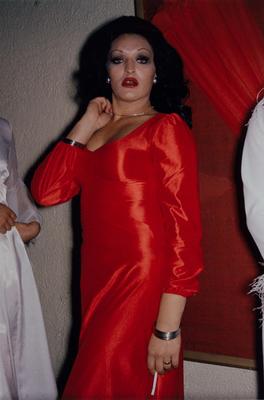Belinda-Lee, Miss NZ Drag Queen 1975, at Mojos Nightclub, Auckland
-
Fiona Clark
b.1954

Title
Belinda-Lee, Miss NZ Drag Queen 1975, at Mojos Nightclub, Auckland
Details
| Production Date | 1975 2010 |
|---|---|
| Collection(s) | Collection Govett-Brewster Art Gallery, New Plymouth. Purchased from Monica Brewster Bequest in 1981. |
| Accession Number | 81/12 |
| Media | Colour photograph - original work; Colour photograph on Ilford Galerie Gold Fiber Silk - reproduced work |
| Measurements | 243 x 161mm - original work; 243 x 161mm with 15mm border - reproduced work; Framed: 475 x 375 x 25mm |
About
In the early 1970s, Fiona Clark, then a student at Elam School of Fine Arts, began photographing Auckland’s gay, lesbian and transgender community. Her photographs record a time of intense social change in New Zealand, and a community of individuals who, by their very existence, posed a challenge to conservative social order. Clark faced censorship in 1975 when two of her photographs taken at a Gay Lib dance at Auckland University toured the country as part of the exhibition The Active Eye. Headlines of outrage accompanied the show around the country; “Mayor shocked by dancing pictures” and “Gallery withdraws ‘indecent’ exhibition”. The photographs were removed from view at many venues, and the exhibition never opened in Auckland.
Twenty-seven years later in 2002, the photographs were shown again in the ground-breaking exhibition Go Girl at the Govett-Brewster Art Gallery. Recent portraits and video interviews with some of the original subjects supplemented Clark’s larger body of work from the 1970s. For Clark, the continued survival of the community is a key element to understanding her 1970s photographs. As such, this body of work tracks a 27-year period of ‘coming out’ in New Zealand.
Belinda-Lee, Miss NZ Drag Queen 1975, at Mojos Nightclub, Auckland is a richly significant image. Belinda-Lee gazes down the lens with all the glamour and seduction of a movie star. However, there are cracks in this surface. Below the shimmering fabric of the curtain backdrop we can see the corner of a stained wall. This is a world of improvisation, and Clark’s camera captures the difficulty of this process of becoming, the slippery oscillation between the theatrical and the mundane. For Belinda-Lee, Clark’s photograph offers some permanence to an identity under duress. The spangles and artifice become what is really real in this photographic tribute to lives lived outrageously, courageously and with screen-goddess style.


